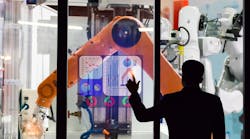SLC 2020 Q&A: Work to Zero: Leveraging Technology to Eliminate Serious Injuries and Fatalities
Over the past 25 years, technology has helped reduce workplace injuries. The same can’t be said for workplace fatalities.
In response, the National Safety Council has launched a Work to Zero initiative, which seeks to identify technology that can make workplace deaths a thing of the past.
Emily Whitcomb, Director of the Work to Zero initiative, will share research results, practical insights and possible solutions (e.g., augmented and virtual reality, drones, machine learning, sensors and wearables, robots and cobots) during her session at the 2020 Safety Leadership Conference, which takes place Nov. 10-12 virtually.
She previews her session, “Work to Zero: Leveraging Emerging Technology to Eliminate Workplace Serious Injuries and Fatalities,” in a Q&A with EHS Today.
EHS Today: Can you offer us a short description of your presentation and describe how it relates to safety leadership?
Whitcomb: Safety innovation has come a long way, from canaries in the coal mine to digital, wearable gas monitors. From steelworkers sitting, untethered, on top of the skyline to drones allowing workers to keep their feet safely on the ground. We’ve come a long way and through innovation we have seen significant decreases in injury rates over the last 25 years.
Unfortunately, our fatality rates have been stagnant in that period, and thousands of workers are still dying on the job every year. National Safety Council’s Work to Zero initiative wants to push our safety leaders to consider how to design out the risk for workers using innovative safety technologies. In my presentation, I will review the most hazardous situations workers can be in and what relevant technology solutions can mitigate the risk.
Why is the topic of your presentation of interest to you and why is it important to SLC attendees?
My background is in public health, and I have devoted my career to helping others. I took an interest in workplace safety because of the ease of access to helping individuals live their fullest lives. I strongly believe that every worker deserves to return home safe and sound. Better design, eliminating or engineering out the risk should be top of mind for our safety leaders. There are many lifesaving technologies on the market today, so why is adoption so slow? We are on the cusp of the next evolution of our safety journey, and I’m excited to be leading it through the Work to Zero initiative.
What are the takeaways you hope to leave with attendees?
The future of the workplace is upon us, and there are many operational and safety benefits. Understand your top risks; investigate and analyze incidents that had the potential for a serious injury or fatality; and identify technologies that could eliminate or mitigate those risks.
Please share an example of a personal or professional experience you’ve had related to safety leadership or the topic of your presentation.
When I joined the National Safety Council in 2014, I really wanted to make a difference in the lives of those we serve. I came into the Council as a research associate studying the effectiveness of our programs and doing research and development for new programs. I developed a good understanding of what our companies wanted and needed as well as where the biggest issues were.
Around 2017, the Council determined fatigue was a priority area because it was becoming more apparent that fatigue was a top contributor to incidents and injuries. I took the leap and stepped over to build and launch our fatigue initiative. Fatigue isn’t always a well-received topic because it is so ingrained in our culture. I persisted in making the case that fatigue is much more prevalent and dangerous than we realize and developed a toolkit of resources for employers. While I found that initiative to be very important, I started to become interested in the future of the workplace and how technology can be used to keep workers safe by eliminating the risk of human error.
In 2019, I stepped over to the Work to Zero initiative, and I am excited to be leading this very important work aimed at eliminating workplace fatalities by 2050. I have devoted my career to helping others, and I hope that my journey at the Council has demonstrated safety leadership and inspired others to do so as well.
What impact has the COVID-19 pandemic had on safety leadership at your organization?
When it became apparent that COVID-19 was a significant threat, the National Safety Council launched our SAFER initiative (nsc.org/safer). The first activity was to pull together a SAFER Task Force of safety leaders across the country. Members of the Safer Task Force demonstrated fantastic collaboration and leadership by sharing information, resources and lessons learned.
We were able to pull together playbooks, guidance documents, communication tools, etc. as well as quickly establish and share case studies, best practices and lessons learned. It was one of the best demonstrations of safety leadership I’ve seen in my career. Work to Zero and SAFER partnered on a series of webinars to discuss the use of technology to mitigate risk: .
Please provide any additional insight or comments about your topic of discussion.
Work to Zero is actively working on creating resources to help employers learn about and adopt safety technologies. We will be releasing a new website by the end of 2020 with tons of information on hazardous situations and technology solutions.
Editor’s Note: For more information on the 2020 Safety Leadership Conference, including registration, click here.


